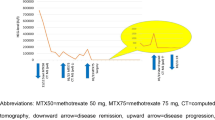Summary
Since 1976 we have used VP16-213 (Etoposide; NSC-141540) in several groups of patients with gestational choriocarcinoma. Initially we used VP16-213 in a dose of 100 mg/m2 by short i.v. infusion for 5 consecutive days in patients with drug-resistant gestational choriocarcinoma. Patients were monitored with twice weekly samples for serum human chorionic gonadotrophin (HCG) concentration and a partial response (PR) has been defined as a fall in the HCG concentration to less than one tenth and an improvement (IMP) as a fall in the HCG concentration to less than one half of the pre-treatment value. In gestational choriocarcinoma patients resistant to other drugs there were 7 (19%) PR, 14 (38%) IMP, and 16 (43%) of non-responders.
Since 1979 we have used VP16-213 as the initial agent in patients in the medium risk category [1] and up to the 1st July 1981 we have treated 38 patients with VP16-213 in this group. There have been 13 (34%) PR and 17 (45%) IMP. There are currently 30 (79%) patients in complete remission. Six are still on treatment; only two required a change of treatment because of drug resistance and so far there has been only one relapse off treatment.
We have also integrated VP16-213 in combination with methotrexate and actinomycin-D followed by vincristine and cyclophosphamide in the high risk category [1] and have so far treated 24 patients. There are 16 (67%) CR, four patients are still on treatment; only one patient failed to respond at all to therapy and there has been one relapse off treatment. There were three deaths in this high risk group. We think that VP16-213 should be regarded as one of the first line agents in trating patients with gestational choriocarcinoma who fall into the medium and high-risk categories.
Similar content being viewed by others
References
Bagshawe KD (1976) Risk and prognostic factors in trophoblastic neoplasia. Cancer 38:1373
Bagshawe KD (1978) Trophoblastic disease. Adv Obstet Gynecol 19:225
Hammond CB, Borchert LG, Tyrey L, Creasemen WT, Parker RT (1973) Treatment of metastatic trophoblastic disease: good and poor prognosis. Am J Obstet Gynecol 115:451
Hilgers RD, Lewis JL (1974) Gestational trophoblastic neoplasms. Gynecol Oncol 2:460
Li MC, Hertz R, Specner DB (1956) Effect of methotrexate therapy upon choriocarcinoma and chorioadenoma. Proc Soc Exp Biol Med 93:361
Newlands ES, Bagshawe KD (1980) Anti-tumour activity of the epipodophyllin derivative VP16-213 (Etoposide; NSC-141540) in gestational choriocarcinoma. Eur J Cancer 16:401
Ober WB, Edgcomb JH, Price EB (1971) The pathology of choriocarcinoma. Ann NY Acad Sci 172:299
Author information
Authors and Affiliations
Rights and permissions
About this article
Cite this article
Newlands, E.S., Bagshawe, K.D. The role of VP16-213 (Etoposide; NSC-141540) in gestational choriocarcinoma. Cancer Chemother. Pharmacol. 7, 211–214 (1982). https://doi.org/10.1007/BF00254552
Accepted:
Issue Date:
DOI: https://doi.org/10.1007/BF00254552




